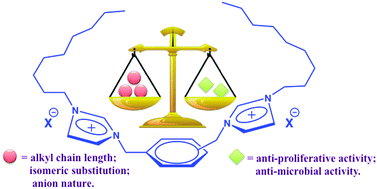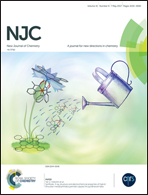The effects of structural changes on the anti-microbial and anti-proliferative activities of diimidazolium salts†
Abstract
An array of diimidazolium salts has been synthesized and used to investigate their anti-microbial and anti-proliferative activities. In particular, salts based on the 3,3′-di-n-alkyl-1,1′-(1,n-phenylenedimethylene)diimidazolium cation and differing in the alkyl chain length on the imidazolium ion, the isomeric substitution on the aromatic spacer and in the anion nature were used. The anti-proliferative activity was evaluated against cervical (HeLa), colon adenocarcinoma (HT-29) and breast (SKBR3) cancer cell lines. In the latter case, also a morphological assessment after treatment with salts was performed. All salts were tested for their hemolytic activity against human erythrocytes. On the other hand, the anti-microbial activity was investigated using both Gram-negative (Escherichia coli) and Gram-positive (Kokuria rhizophila, Staphilococcus aureus and Bacillus subtilis) strains. On the whole, the data collected demonstrate that biological activity is the result of the combined action of both cation and anion structures. In general, the cation hydrophobicity plays the most significant role with structural features of the anion becoming more relevant in the presence of a shorter alkyl chain on the cationic head.



 Please wait while we load your content...
Please wait while we load your content...